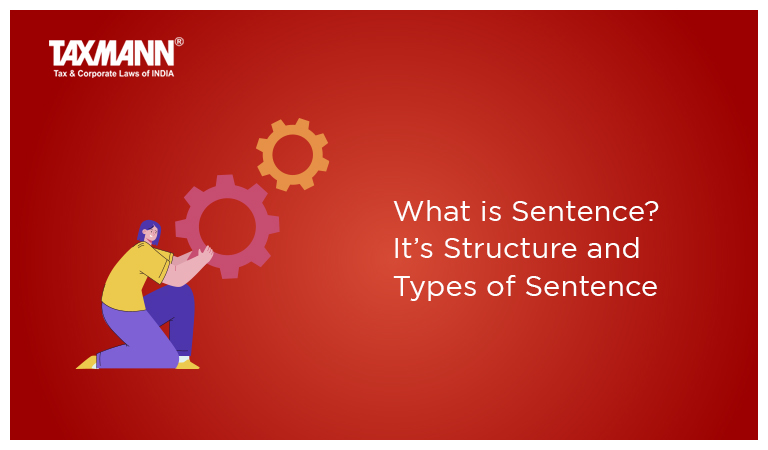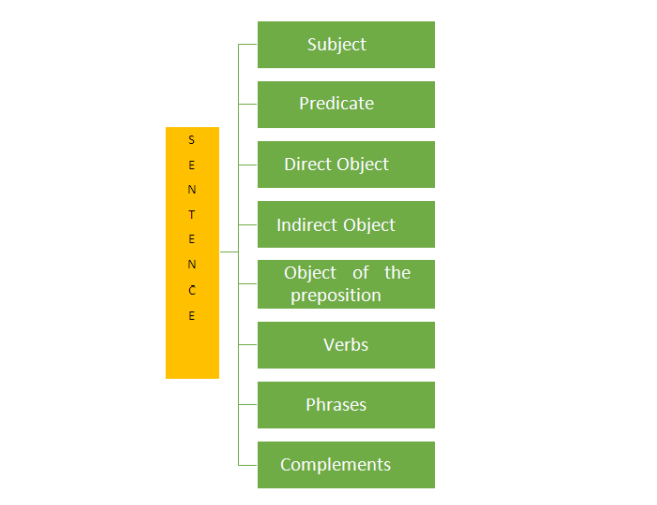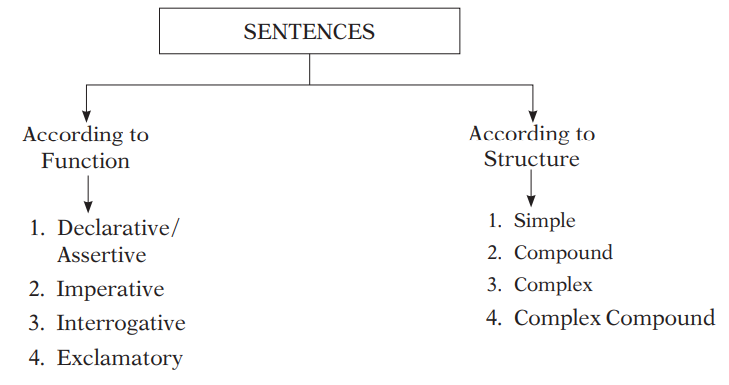What is Sentence? It’s Structure and Types of Sentence
- Other Laws|Blog|
- 12 Min Read
- By Taxmann
- |
- Last Updated on 9 November, 2023

Table of Contents
3.1 Classification According to Function
3.2 Classification According to Structure
Check out Taxmann's Business Correspondence & Reporting (BCR) | Study Material which provides the subject matter in simple and lucid language. The coverage & presentation of the book is topic-wise. It includes word examples, test questions, a quick revision section, etc. CA Foundation | New Syllabus | Dec. 2022 Exams
Grammar is the set of rules that govern the structure of language. Language evolves and changes over time. Knowledge of grammar helps in spoken and written communication. Three basic units which constitute the structure of language are – Phrase, Clause and Sentence. A phrase is a group of words that makes incomplete sense. It is a part of a sentence and cannot stand alone. It does not include a subject and a verb. For example.
-
- in the south
- a pink dress
- at ten o’clock
A clause is a group of words consisting of a subject and a predicate. It can make complete sense on its own. It may or may not be part of a sentence. Clauses are of two types :
Main or independent clause : A main clause can stand by itself as a complete sentence and function as a simple sentence. It consists of a subject and a predicate. For example :
-
- She has a diamond ring
- Ashok lives in Dubai
In the above examples, She and Ashok are subjects. Has a diamond ring and lives in Dubai are predicates Also, the whole clause makes complete sense.
Subordinate or Dependent Clause : A subordinate clause does not make complete sense on its own. It is dependent on the main clause. However, it consists of a subject and a predicate, For example :
-
- She has a ring which is made of diamonds
- This is the place where Himalaya was buried.
The words in italics are the subordinate clauses. As they on their own do not make complete sense and are dependent on the main clause She has a ring and This is the place.
1. Definition of a Sentence
A sentence means a group of words that makes complete sense. It begins with a capital letter and ends with a full stop. It always contains a finite verb. A sentence may be a statement, question, exclamation or command. It consists of a main clause and one or more subordinate clauses. A sentence may be short and simple or long and complex. For example:
-
- She likes Sweets
- She likes Bengali Sweets
- She likes Bengali Sweets which are made of milk
- She likes Bengali Sweets which are made of milk and are tasty
2. Structure of a Sentence

Illustration: Components of a Sentence
A sentence consists of the following parts :
1. Subject : The person or thing about which something is stated is called subject.
2. Predicate : It is that part of a sentence that tells something about the subject.
-
-
- His sister works in London
- The flight arrived late
- This is my car
- The young lady was running
- The temperature in Gulmarg is zero degree
-
In the above sentences the italicized words are the subjects while the other words are the predicates.
3. Direct Object : A person or thing which receives the action of the verb is the direct object. It comes after the verb and answers the question ‘What’. For example:
-
-
- Sohan ate breakfast
- The breakfast was tasty
- Naina read the book
- He repaired his mobile
- I have written a book
-
In the above sentences, italicised words are direct objects. Sentence structure is Subject, Verb, Direct Object.
4. Indirect Object : A person or thing that the action is done to or for is known as the indirect object. It is the receiver of the direct object. It follows the verb and answers the questions ‘Whom’. The indirect object usually comes just before the direct object. For example :
-
-
- She made Rava dosa for breakfast
- Deepak is sending his wife an e-mail right now
- Rohan has made his mother promise to work hard
- Ms. Gupta teaches them communication skills
-
In the above sentences, italicized words are indirect objects. Sentence structure is Subject, Verb, Indirect Object, Direct Object.
5. Object of the Preposition : It is a noun or pronoun that provides meaning. The noun that comes after the preposition is called the object of the preposition. For example :
-
-
- The cat is looking at the mouse
In this sentence “the mouse” is the object of the preposition “at”. - They are going to ooty
Here “ooty” is the object of the preposition “to”.
- The cat is looking at the mouse
-
Object of the preposition is different from the indirect object. The object of the preposition comes immediately after the preposition whereas the Indirect object does not come immediately after the preposition. Moreover, the indirect object is usually followed by the direct object but this rule does not apply to object of the preposition. For example :
-
-
- Mohan gave Monika the book.
- Mohan gave the book to Monika
-
In the first sentence Monika is the indirect object. In the second sentence Monika is the object of the preposition “to”. The meaning of both the sentences is the same but their structure is different.
6. Verbs : A verb means that part of speech which describes an action or occurrence. For example,
-
-
- John ran a mile.
- Perry is a teacher.
- We know the solution to this problem.
-
Verbs are of the following types according to their function in the sentence.
(i) Finite Verbs : A finite verb (or main verb) agrees with its subject in person and number. It forms the main clause of a sentence. It also changes according to the tense of the sentence. For example:
-
-
-
- She is a professor
- They are professors
- She goes to college five days a week
- They go to college five days a week
-
-
In the above sentences, italicized words are finite verbs.
(ii) Non-Finite Verbs : A verb that does not change according to the person, number and tense of the sentence is called a non-finite verb. Non-finite Verbs are of three types :
(a) Infinitive : It is generally used like a noun. Generally the word “to” is used before the infinitive verb. For example:
-
-
-
-
- To err is human
- To forgive is divine
- Asha loves to sing
-
-
-
In the above sentences, italicised words are infinitive verbs
(b) Participle : It is a verb which can be used as an adjective. Present participle ends with ing and the past participle ends with ed or t. For example :
-
-
-
-
- We saw the breaking news today at 7 p.m.
- The broken glass cut my foot.
- The food tasted like a burnt log.
-
-
-
In the above sentences italicised words are participles
(c) Gerunds : A gerund is a verb but acts as a noun. It ends with ing. For example:
-
-
-
-
- She likes reading poetry.
- Playing football is not allowed in this park.
- Running is a healthy activity.
- Painting keeps me busy.
- I enjoy dancing to classical music.
-
-
-
In the above sentences italicised words are gerunds.
(iii) Auxiliary Verbs : The verbs ‘be’, ‘have’ and ‘do’ which are used with main verbs to make tenses, passive forms, questions and negatives are known as auxiliary or helping verbs. These include is, own, are, was, were, has, have, had, does, do, did. For example:
There are 23 auxiliary verbs that can be remembered using the abbreviation “CHAD B SWIM”
| C | H | A | D | B | S | W | I | M |
| Can could | Has Had have |
Am are |
Do Does did |
Be Being been | Shall should | Was Will Were would |
is | May might must |
-
-
-
-
- She is working on her dissertation
- This song was sung by Lata Mangeshkar
-
-
-
(iv) Modals : Modals are used before main verbs to express meanings such as ability, permission, possibility and obligation. For example :
| Can | Must | Should |
| Could | Will | Need to |
| May | Would | Ought to |
| Might | shall | Used to |
-
-
-
- Geeta can drive a truck (ability)
- You may go (permission)
- We should speak truth (obligation)
- It might rain tonight. (possibility)
- The temperature might drop tonight. (possibility)
-
-
(v) Transitive Verbs : The Verbs which always have direct objects. In other words, these give action to someone or something: Therefore, these are also called action verbs which express doable activities. For example :
-
-
-
- Ramesh told a lie
- The traffic police fined the driver
- The dog licked the bread
-
-
(vi) Intransitive Verbs : An intransitive verb indicates an action that does not pass over to an object. It merely expresses a state or being. For example:
-
-
-
- The watchman remains awake (state)
- There is a snag (being)
- She danced (action)
-
-
7. Phrases : A phrase means a group of words that makes some sense but not complete sense. It acts as a single part of speech. It may not have a subject, or a predicate or both. Phrases are of the following types:
(i) Prepositional Phrase : It is a group of words that begins with a preposition and ends with a noun or pronoun or gerund. For example :
-
-
-
- He gave the job to her
- Her car is struck in traffic jam
- The army works for the entire country
-
-
A prepositional phrase is generally used as an adjective or adverb. When used as an adjective, it comes after the noun or pronoun which it is describing. The objective case of a pronoun (me, him, her, us, them, whom) is used a prepositional phrase.
Mughal Garden is part of the Rashtrapati Bhawan Estate
In this sentence ‘of is the preposition Rashtrapati Bhawan Estate is a noun’ and is the object of the preposition.
The phrase decided the word ‘part’
(ii) Noun Phrase : A noun phrase consists of a single noun or pronoun and its modifiers. It does the function of a noun. It may be used as a subject, an object or a complement. For example:
-
-
-
- The dark, foul smoke engulfed the locality (noun phrase as subject)
- Namita does a lot of office work at home (noun phrase as object)
- The constitution club is a great place for a press conference (noun phrase as complement)
-
-
(iii) Verb Phrase : In a verb Phrase, a main verb and one or more helping verbs are linked together. It serves as the predicate of a clause or sentence. It defines the different times of the action. For example:
-
-
-
- I have read a book
- I was reading a book
- I have already read a book
- I must have been reading a book
-
-
8. Complements : A word or a group of words that completes the meaning of a subject, an object, or a verb is known as complement:
(i) Subject complement : A subject complement modifies or refers to the subject and follows a verb. It may be a noun or an adjective for example:
-
-
-
- Taj Mahal is Magnificent : (The adjective magnificent is a subject complement that describes the subject Taj Mahal).
- Mr. Anoop Jalota is a bhajan Singer (The noun phrase bhajan singer describes Mr. Anoop Jalota).
-
-
(ii) Object Complement : It modifies and follows an object. For example :
-
-
-
- Voters elected her a member of the Parliament (Member of Parliament describes the direct object her).
- I consider smoking cigarettes harmful to health (Cigarettes is the direct object, harmful to health describes it).
-
-
(iii) Verb Complement : Direct or Indirect object of a verb is called verb complement. It may be a noun, pronoun, or word/group of words acting as a noun. For example :
-
-
-
- Naina gave Mohan my umbrella (Mohan is the indirect object, my umbrella is the direct object of the verb gave. Both are verb complements)
-
-
3. Types of Sentences

3.1 Classification According to Function
1. Declarative/Assertive Sentences : These sentences make a declaration in the form of a statement, an opinion, a suggestion, a proverb or a universal truth. These can be positive or negative but always end with a full stop. For example:
-
-
- The teacher is going to the class room (simple statement)
- Sunita is a good singer (opinion) (declaration)
- The sun rises in the east. (universal truth)
- Barking dogs seldom bite (proverb)
-
2. Imperative Sentences : These sentences express an order, command, advice, request, proposal or suggestion. These may end with a full stop or exclamation depending on the imperative word. For example:
-
-
- Get out (Command)
- Always Speak the truth (Advice)
- Please be patient (request)
- Let’s go to the book fair (suggestion)
-
3. Interrogative Sentences : These sentences ask questions. ‘Wh’ and a verb are used to frame an interrogative sentence. A question mark comes after such a question. For example:
-
-
- Who is your father?
- When are you going to London?
- Do you have any money?
- Are you feeling alright?
-
4. Exclamatory Sentences : These sentences express strong emotions or feelings such as joy, surprise, wonder, regret, etc. An exclamatory sentence ends with an exclamation mark. For example :
-
-
- Alas! India lost the match. (regret)
- Hurray! My daughter passed the IIT examination (joy)
- Oh my God! It is raining. (surprise)
- What a shame! (regret)
- What a beautiful scene! (wonder)
-
3.2 Classification According to Structure
5. Simple Sentences : There is only one subject one predicate and one finite verb in a simple sentence. It contains only one independent clause. For example :
-
-
- She sings (She is the subject and sings is the predicate)
- The dog ran after the ball (Dog is the subject and ran after the ball is the predicate).
-
Either subject or verb can be compound (meaning two or more), but the key is there always remains only ONE independent clause. For example:
-
-
- Blue is her favourite colour.
- Blue and Red are her favourite colours.
- Sam loves and hates pink.
-
The examples above are all simple sentences, though some contain compound elements.
Example one has a simple subject (Blue) and a simple verb(is).
Example two has a compound subject (Blue and Red) and a simple verb (are).
Example three has a simple subject (Sam) and a compound verb (loves and hates). However, they are all still considered simple sentences because there is no dependent clause that can stand alone.
6. Compound Sentences : There are two or more independent/main clauses in a compound sentence. A comma, a colon, a semi-colon is used to join these clauses. Conjunctions used to join similar elements (e.g. two nouns, two verbs, two modifiers) are called coordinating conjunctions (Here is a list of co-ordinating conjunctions for future compound sentences you will write: for, and, nor, but, or, yet, so. An easy way to remember these is the acronym FANBOYS.)
-
-
- It rained heavily throughout the day; consequently, the city was flooded
- The thief ran to escape but the police caught him
- The winter set in, it was cold and we took out woollens from the cupboard
- She is neither honest nor sincere.
-
some more examples
-
-
- I called her twice yet she did not come.
- Sam enjoys reading; John prefers sports.
- Betty and Joy arrived at the party early, but Sam got the relate.
-
7. Complex Sentences : There is one main clause and one or more subordinate (dependent) clauses in a complex sentence. The subordinating conjunction indicates time, place, manner, reason, conditions or concession and provides a link between the clauses. For example:
-
-
- The robber ran away when he saw the police
- When the robber saw the police, he ran away because he was terrified
-
In the above sentences, italicised words constitute the main clause. The remaining words are subordinate clause (D).
-
-
- She returned the computer after she noticed it was damaged.
- When the cost goes up, customers buy less clothing.Since winter is coming I think I’ll knit a warm sweater because I’m always cold.
-
In complex sentences, subordinate clauses function within the sentence as adjectives, adverbs, or nouns. For example:
Rohan was tired. (Simple sentence)
Rohan went to bed. (Simple sentence)
-
-
- Rohan went to bed because he was tired.
- Because he was tired, Rohan went to bed.
- Rohan who was tired went to bed. (noun clause)
-
Rohan, although he was tired, went to bed late. (adverb clause)
Subordinating conjunctions
| Conjunctions | Conjunctions | Relative |
| Concession | Time | Adjective |
| though | after | that |
| although | as long as | what |
| even though | before | whatever |
| while | by the time | which |
| now that | whichever | |
| Conjunctions | once | |
| Condition | since | Relative |
| if | til | Pronoun |
| only if | until | who |
| unless | when | whom |
| until | whenever | whoever |
| providing that | while | whomever |
| assuming that | whose | |
| even if
in case (that) |
||
| Conjunctions | ||
| Manner | ||
| Conjunctions | Conjunctions | how |
| Comparison | Reason | as though |
| than | because | as if |
| rather than | since | |
| whether | so that | Conjunctions |
| as much as | in order (that) | Place |
| whereas | why | where |
| wherever |
8. Complex Compound Sentences : A Complex compound sentence consist of two or more independent clauses plus one or more dependent clauses. For example:
-
-
- Smita smiled brightly and laughed delightedly when he saw her new scooty.
- Although it was raining, I left my house, as I had to attend an important meeting.
-
Some more examples
-
-
- Jay’s mother went to the store because it’s his birthday, and she bought him a present.
- The team captain jumped for joy and the fans cheered because we won the state championship.
-
| Simple sentence — Independent clause
Compound sentence — Independent clause, *Independent clause Complex sentence — Independent clause *(two or more) dependent clause Compound complex — (2 or more) Independent clauses *(2 or more) dependent clauses |
3.3 Subject-Verb Agreement
In a grammatically correct sentence, the subject and finite (main) verb are always in agreement with each other in the present tense. For example,
-
- The dog plays with the ball.
- The dogs play with the ball.
Rules for subject-verb agreement
1. The subject and the verb agree with each other. The agreement is not affected by the phrase in between them.
For example,
Polly, who is a dentist, loves to eat candies.
The teachers, as well as the Principal, want to attend the book fair.
One of the team members is sick.
2. In case the subject is composed of compound nouns or pronouns connected with “and” always use a plural verb.
For example,
Carol and Sheila are skating in the rink.
He and his brother work in the same organization.
The Prime minister and the President are both in agreement over the issue.
3. In case the subject is composed of two or more singular nouns or pronouns connected with “or”/ “nor” always use a singular verb.
For example,
David or Jane is in-charge of this project.
Pink or Red is the theme colour of the party.
Love or hate is a strong emotion.
4. In the case of both singular and plural subjects connected with “or”/ “nor” the verb agrees with the part of the subject closer to the verb.
For example,
My sister or her colleagues are going on a trip.
Her colleagues or my sister is going on a trip.
Neither Taylor nor Selena won the Grammy’s this year.
5. Don’t is always used with the plural subject and “Doesn’t” is used with a singular subject. (exception to the rule, I and You)
For example,
Roses don’t bloom in winters.
The train doesn’t stop at the station for long.
They don’t want to attend the meeting in the afternoon.
He doesn’t like to attend the meeting in the afternoon.
6. Collective nouns like group, team, class require singular verbs.
For example,
The Indian Army is the pride of our nation.
The class is dismissed.
The jury is not convinced with the evidence.
7. Words such as each, everyone, anyone, no one, nobody, anybody, everybody require a singular verb.
For example,
Everybody is invited to the party.
No one is left behind.
Each one of the boxes is sealed.
Anyone wants to eat chocolate.
8. In Sentences beginning with there the verb agrees with the subject that comes after the verb.
For example,
There is no sugar in the pot.
There are ripe mangoes in the refrigerator.
9. Nouns which have two parts always require a plural verb.
For example,
These cotton trousers are expensive.
Scissors are made of steel.
My shoes are biting my toes.
Be careful the tongs are hot.
Disclaimer: The content/information published on the website is only for general information of the user and shall not be construed as legal advice. While the Taxmann has exercised reasonable efforts to ensure the veracity of information/content published, Taxmann shall be under no liability in any manner whatsoever for incorrect information, if any.

Taxmann Publications has a dedicated in-house Research & Editorial Team. This team consists of a team of Chartered Accountants, Company Secretaries, and Lawyers. This team works under the guidance and supervision of editor-in-chief Mr Rakesh Bhargava.
The Research and Editorial Team is responsible for developing reliable and accurate content for the readers. The team follows the six-sigma approach to achieve the benchmark of zero error in its publications and research platforms. The team ensures that the following publication guidelines are thoroughly followed while developing the content:
- The statutory material is obtained only from the authorized and reliable sources
- All the latest developments in the judicial and legislative fields are covered
- Prepare the analytical write-ups on current, controversial, and important issues to help the readers to understand the concept and its implications
- Every content published by Taxmann is complete, accurate and lucid
- All evidence-based statements are supported with proper reference to Section, Circular No., Notification No. or citations
- The golden rules of grammar, style and consistency are thoroughly followed
- Font and size that’s easy to read and remain consistent across all imprint and digital publications are applied






